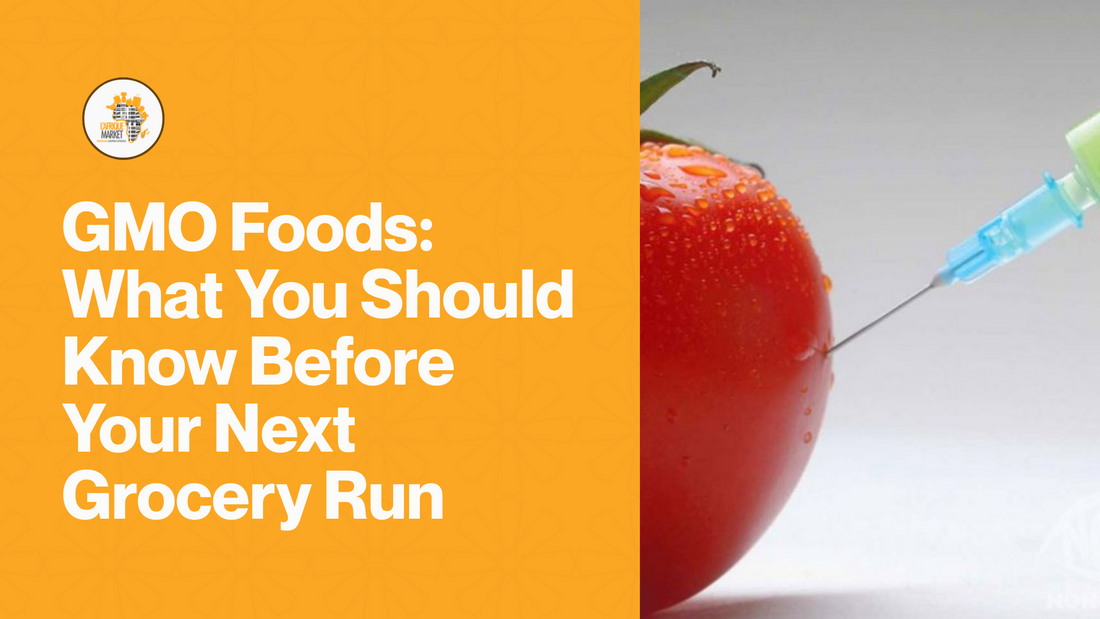
GMO Foods: What You Should Know Before Your Next Grocery Run
Share
What Are GMO Foods?
GMO stands for Genetically Modified Organism. In simple terms, GMO foods are created when the DNA of a plant or animal is altered in a laboratory to achieve specific results — like resistance to pests, longer shelf life, or higher nutritional content.
This process is not the same as traditional crossbreeding or hybridization. Instead, scientists use modern biotechnology to insert genes from one organism into another — sometimes even across species (e.g., adding bacterial DNA to corn to make it resistant to insects).

Image from: Dr Earth
Common GMO Foods You Might Be Eating
Although you may not realize it, many foods in grocery stores are genetically modified. In the U.S., for example, the most common GMO crops are:
- Corn (used in snacks, syrups, oils, and even drinks)
- Soybeans (soy milk, soy flour, tofu, cooking oils)
- Canola
- Cotton (used for cottonseed oil)
- Sugar beets
- Papaya (especially from Hawaii)
- Squash (zucchini and yellow varieties)

Image from: EcoJesuit
According to the FDA, over 90% of corn, soybeans, and cotton grown in the U.S. are genetically engineered (source: FDA.gov).
Also read: Where to Buy Authentic African Ingredients in Chicago
Why Are GMO Foods Created?
Genetically modifying food isn’t just about science; it’s also about efficiency, food security, and sustainability. Some of the reasons GMOs were introduced include:
- Pest Resistance: Crops like Bt corn can naturally fend off insect attacks without chemical pesticides.
- Drought Resistance: Some GMO crops grow with less water, ideal for dry climates.
- Increased Yield: Farmers can grow more food on the same land.
- Shelf Life: GMO tomatoes or bananas can last longer without spoiling.
- Enhanced Nutrition: Some GMOs are modified to have more vitamins (e.g., Golden Rice enriched with Vitamin A).
Are GMO Foods Safe?
According to numerous global health organizations, including the World Health Organization (WHO), American Medical Association (AMA), and the National Academy of Sciences, GMO foods currently on the market are safe to eat and pose no greater health risk than conventional foods.
“GMOs are regulated for safety by the USDA, FDA, and EPA, and undergo years of testing before approval.” — FDA.gov
However, the debate around GMOs is not only about safety. It's also about ethics, biodiversity, labeling transparency, and the control of seeds by large corporations.
What’s the Debate All About?
Concerns about GMOs include:
- Long-term health effects (still being studied)
- The rise of pesticide-resistant weeds (when crops are engineered to resist herbicides)
- Seed patents are controlled by a few major biotech companies
- Contamination of native plant species
In many African countries, GMO food adoption is still limited or under review, with governments and citizens cautious about the long-term impact on agriculture, food culture, and local economies.
How to Recognize GMO Foods (And What to Look for When You Shop)
With more conversations around food safety, sustainability, and clean eating, many people are asking: “How can I tell if my food is genetically modified?”

Image from: Canterbury Naturals
Genetically Modified Organisms (GMOs) are common in the global food supply, especially in processed foods. While they’re considered safe by major health organizations, knowing how to recognize them gives you more control over what you eat.
Here’s a breakdown of how to identify GMO foods, according to reliable sources.
1. Read the Food Label Carefully
a. Look for “Bioengineered” on U.S. Labels
Since January 2022, the U.S. Department of Agriculture (USDA) requires that foods with detectable levels of GMO content carry a “bioengineered” label under the National Bioengineered Food Disclosure Standard.
This label may appear as:
- A text disclosure (e.g., “Contains a bioengineered food ingredient”)
- A QR code you can scan
- A small symbol (often a leaf inside a circle with a smiley sun)
✅ Source: USDA Agricultural Marketing Service
b. Look for “Non-GMO” or “GMO-Free” Seals
Some manufacturers voluntarily add a “Non-GMO Project Verified” label. This is the most recognized third-party certification in North America and assures the product was made without genetically modified ingredients.
The Non-GMO Project label features an orange butterfly on a green blade of grass.
Source: Non-GMO Project
2. Know Which Foods Are Commonly GMO
Certain crops are genetically modified more than others. If you’re buying non-organic or processed food made from the following ingredients, there’s a high chance it may contain GMOs:
- Corn (including corn syrup, corn oil, corn flour, popcorn, etc.)
- Soybeans (soy flour, soy lecithin, tofu, soy milk, etc.)
- Canola (used in oils and margarines)
- Sugar beets (used to make white sugar)
- Cottonseed oil
- Alfalfa (used in animal feed)
- Papaya (from Hawaii or China)
- Zucchini and yellow summer squash
Source: FDA List of GMO Foods
3. Go for Certified Organic Products
In the U.S., certified organic foods are not allowed to contain GMOs. That means:
- No GMO seeds
- No genetically modified animal feed
- No genetic engineering during any step of processing
Look for the USDA Organic seal if you’re shopping in international or export-focused stores.
Source: USDA Organic Standards
4. Be Cautious with Highly Processed Foods
Many packaged snacks, sauces, cereals, and baked goods contain ingredients derived from GMO crops, especially:
- High-fructose corn syrup
- Soy protein isolate
- Canola oil
- Lecithin
- Corn starch
- Dextrose and maltodextrin
Unless these products are labeled as non-GMO or organic, there’s a strong chance they contain GMOs.
GMOs and African Foods
At L’Afrique Market, we’re committed to authentic, culturally relevant, and wholesome food options. The majority of African pantry staples, like yams, beans, egusi, ogbono, dried fish, crayfish, and native spices, are non-GMO and often organically grown by smallholder farmers.
Still, with globalization, some packaged or imported items (like cooking oils, flours, or snacks) may contain GMO ingredients. That’s why reading labels and shopping from trusted sources is more important than ever.
So… Should You Avoid GMO Foods?
There’s no black-and-white answer.
- If your focus is safety: GMO foods currently approved are considered safe to eat.
- If you prefer traditional farming or non-GMO sourcing, Seek out organic or non-GMO labeled products.
- If you care about food culture and biodiversity: Support brands and markets (like ours!) that work with small farmers and prioritize transparency.
Final Thoughts
As GMO technology continues to evolve, it’s up to you, the consumer, to stay informed. Whether you choose to eat GMO or non-GMO foods, the key is understanding what you're putting in your body and how it fits into your lifestyle.
Looking for non-GMO African pantry staples and traditional foods you can trust?
👉 Explore our collection at LafriqueMarket — where we bring the motherland to your doorstep.
